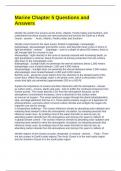Marine Chapter 5 Questions and
Answers
Identify the world's five oceans as the Arctic, Atlantic, Pacific,Indian and Southern, and
understand that these oceans are interconnected and encircle the Earth as a World
Ocean - answer Arctic, Atlantic, Pacific,Indian and Southern
Identify zones found in the open ocean, limited to epipelagic, mesopelagic,
bathypelagic, abyssopelagic and benthic zones, and describe these zones in terms of
light penetration - answer Epipelagic - zone to a depth of about 850 meters, there is
still enough light for a human to see
Mesopelagic - light intensity in this zone is severely reduced with increasing depth, so
light penetration is minimal. About 20 percent of primary production from the surface
falls down to the mesopelagic zone.
Bathypelagic - Sunlight does not penetrate the eternal darkness below 1,000 meters
bathypelagic zone located between 1,000 and 4,000 meters
Abyssopelagic - Sunlight does not penetrate the eternal darkness below 1,000 meters
abyssopelagic zone located between 4,000 and 6,000 meters
Benthic zone - along the ocean bottom from the shoreline to the deepest parts of the
ocean floor. Within the pelagic realm is the photic zone, which is the portion of the
ocean that light can penetrate (approximately 200 m or 650 ft).
Explain the importance of oceans and their interaction with the atmosphere - answer
as carbon sinks - oceans, plants and soils - help to buffer the continued emissions from
human activity. The ocean absorbs CO2 from the atmosphere because, as the
atmospheric concentration increases, more is dissolved in the surface water.
as sources of oxygen - The ocean produces oxygen through the plants (phytoplankton,
kelp, and algal plankton) that live in it. These plants produce oxygen as a byproduct of
photosynthesis, a process which converts carbon dioxide and sunlight into sugars the
organism can use for energy.
in temperature buffering - The oceans influence climate by absorbing solar radiation and
releasing heat needed to drive the atmospheric circulation, by releasing aerosols that
influence cloud cover, by emitting most of the water that falls on land as rain, by
absorbing carbon dioxide from the atmosphere and storing it for years to millions of
in global climate control - The oceans influence climate by absorbing solar radiation and
releasing heat needed to drive the atmospheric circulation, by releasing aerosols that
influence cloud cover, by emitting most of the water that falls on land as rain, by
absorbing carbon dioxide from the atmosphere and storing it for years to millions of
Identify regions of the oceans as polar, temperate, or tropical - answer Polar - There
are two oceans in Earth's polar regions.The Arctic Ocean is in the north polar region
and the Southern Ocean is in the south polar region.
, Temperate - Temperate oceans are located between the Tropics of Cancer and
Capricorn and the north and south polar regions of the globe. Temperate oceans, such
as regions of the Atlantic and Pacific oceans, include both subtropical and subpolar
locations.
Tropical - Tropical oceans include the central portion of the Pacific and Atlantic Oceans,
as well as the Caribbean Ocean and most of the Indian Ocean. Temperate oceans are
located between the Tropics of Cancer and Capricorn and the north and south polar
regions of the globe.
Describe the conditions required for tropical coral reef formation - answer Many grow
optimally in water temperatures between 73° and 84° Fahrenheit (23°-29°Celsius), but
some can tolerate temperatures as high as 104° Fahrenheit (40° Celsius) for short
periods. Most reef-building corals also require very saline (salty) water ranging from 32
to 42 parts per thousand.
Describe and compare the four types of tropical coral reef: fringing, barrier, patch and
atoll, in terms of their proximity to the coast and lagoon structure (if present) - answer
Fringing - Fringing reefs are located near shore in the tropicsin many areas and are the
most common reef type. Coral reefs are found in the tropics in which the water is
between 18 and 30 °C (64 and 86 °F). Many of the Great Barrier Reef's components are
actually fringing reefs.Fringing reefs grow near the coastline around islands and
continents. They are separated from the shore by narrow, shallow lagoons. Fringing
reefs are the most common type of reef. Barrier reefs also parallel the coastline but are
separated by deeper, wider lagoons.
Barrier - Barrier reefs are similar to fringing reefs in that they also border a shoreline;
however, instead of growing directly out from the shore, they are separated from land by
an expanse of water. This creates a lagoon of open, often deep water between the reef
and the shore.
Patch- Patch reefs are small, isolated reefs that grow from the open bottom of an island
platform or continental shelf, typically within lagoons.
Atoll - An atoll is a ring-shaped coral reef, island, or series of islets. An atoll surrounds a
body of water called a lagoon. Sometimes, atolls and lagoons protect a central island.
Channels between islets connect a lagoon to the open ocean or sea.
Describe corals as animals in the Phylum Cnidaria that form sessile colonies of polyps,
often having a symbiotic relationship with zooxanthellae - answer NOTES
Understand that there are two general types of coral, hard (for example, staghorn) and
soft (for example, sea fan) which are characterized by the extent of calcification and the
presence of zooxanthellae - answer Apart from their swaying bodies and jelly-like
feel, soft corals also have eight tentacles on each polyp. The tentacles have a feathery
appearance, whereas hard corals have smooth tentacles. Soft corals tend to be brightly
coloured, with bright pinks and mauves rarely seen in hard corals.
Describe the structure of a typical coral polyp, limited to tentacle, nematocyst, mouth,
stomach, calyx, theca and basal plate, and describe the functions of these structures -




